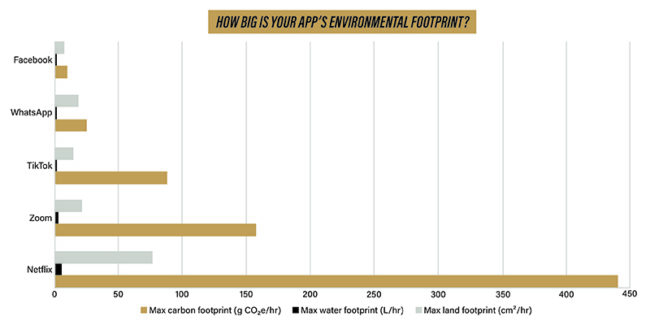
Generally I tend to leave the camera off when in virtual meetings. Not because of my lockdown haircut (or lack of one), nor is it to hide the disorganised clutter all around me, but for a far more practical reason. If I turn the camera on, then my network starts playing up. My rural location means that I’m not exactly getting the best broadband line. Out here nobody is going to be running fibre to the premises so I’m stuck with copper wires, aka two-tin-cans and a piece of string.
Sigh!
It turns out that not only have I been avoiding network glitches, but according to a newly published study, I’m also being rather kind to the planet as well.
The overlooked environmental footprint of increasing Internet use
(The details below comes via Materials provided by Purdue University)
The study, conducted by researchers from Purdue University, Yale University and the Massachusetts Institute of Technology, is the first to analyze the water and land footprints associated with internet infrastructure in addition to carbon footprints. The findings are published in the journal Resources, Conservation & Recycling.
Our pandemic-driven shift to remote work and more at-home entertainment still presents significant environmental impact due to how internet data is stored and transferred around the world.
Just one hour of videoconferencing or streaming, for example, emits 150-1,000 grams of carbon dioxide (For context, a gallon of gasoline burned from a car emits about 8,887 grams), requires 2-12 liters of water and demands a land area adding up to about the size of an iPad Mini.
Camera Off
Leaving your camera off during a web call can reduce these footprints by 96%. Streaming content in standard definition rather than in high definition while using apps such as Netflix or Hulu also could bring an 86% reduction, the researchers estimated.
“If you just focus on one type of footprint, you miss out on others that can provide a more holistic look at environmental impact,”
Roshanak “Roshi” Nateghi, a Purdue professor of industrial engineering, whose work looks to uncover gaps and assumptions in energy research that have led to underestimating the effects of climate change.
The Impact All Adds up
A number of countries have reported at least a 20% increase in internet traffic since March. If the trend continues through the end of 2021, this increased internet use alone would require a forest of about 71,600 square miles – twice the land area of Indiana – to sequester the emitted carbon, the study found.
The additional water needed in the processing and transmission of data would also be enough to fill more than 300,000 Olympic-size swimming pools, while the resulting land footprint would be about equal to the size of Los Angeles.
The team estimated the carbon, water and land footprints associated with each gigabyte of data used in YouTube, Zoom, Facebook, Instagram, Twitter, TikTok and 12 other platforms, as well as in online gaming and miscellaneous web surfing. As expected, the more video used in an application, the larger the footprints.

Because data processing uses a lot of electricity, and any production of electricity has carbon, water and land footprints, reducing data download reduces environmental damage.
“Banking systems tell you the positive environmental impact of going paperless, but no one tells you the benefit of turning off your camera or reducing your streaming quality. So without your consent, these platforms are increasing your environmental footprint,
The internet’s carbon footprint had already been increasing before COVID-19 lockdowns, accounting for about 3.7% of global greenhouse gas emissions. But the water and land footprints of internet infrastructure have largely been overlooked in studies of how internet use impacts the environment, ”
Kaveh Madani, who led and directed this study as a visiting fellow at the Yale MacMillan Center.
What did Professor Nateghi’s research group do?
Kaveh Madani from Yale teamed up with a research group led by Purdue professor Roshanak “Roshi” Nateghi, to investigate these footprints and how they might be affected by increased internet traffic. What they found was that the footprints not only vary by web platform, but also by the country. The team gathered data for Brazil, China, France, Germany, India, Iran, Japan, Mexico, Pakistan, Russia, South Africa, the U.K. and the U.S.
Processing and transmitting internet data in the U.S., the researchers found, has a carbon footprint that is 9% higher than the world median, but water and land footprints that are 45% and 58% lower, respectively.
Incorporating the water and land footprints of internet infrastructure painted a surprising picture for a few countries. Even though Germany, a world renewable energy leader, has a carbon footprint well below the world median, its water and land footprints are much higher. The country’s energy production land footprint, for example, is 204% above the median, the researchers calculated.
Purdue graduate students Renee Obringer, Benjamin Rachunok and Debora Maia-Silva performed the calculations and data analysis in collaboration with Maryam Arbabzadeh, a postdoctoral research associate at MIT. The estimates are based on publicly available data for each platform and country, models developed by Madani’s research group and known values of energy use per gigabyte of fixed-line internet use.
The estimates are rough, the researchers say, since they’re only as good as the data made available by service providers and third parties. But the team believes that the estimates still help to document a trend and bring a more comprehensive understanding of environmental footprints associated with internet use.
“These are the best estimates given the available data. In view of these reported surges, there is a hope now for higher transparency to guide policy,”
Roshanak “Roshi” Nateghi, a Purdue professor.
It Really does matter
Using data to work out what is actually going on is a rather important step in many different contexts.
The use of Zoom, Skype, Teams, Meet-me, or similar, feels very green because we are avoiding the alternative high-carbon cost of face-to-face. However, in the context of getting to net-zero carbon, it turns out that virtual meetings (and Netflix) do also have a carbon cost. Understanding that also enables us to appreciate small things, such a camera off. and that doing that can have a huge environmentally beneficial impact.
